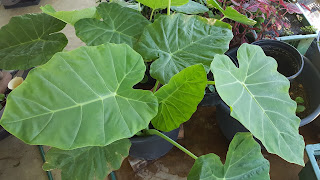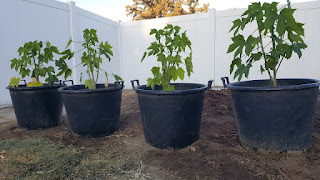ក្តាត, Bạc Hà (Xanthosoma or Colocasia gigantea?
'ក្តាត' in Khmer, Bạc Hà in Vietnamese. I leave it unnamed because what information I found online is confusing and unreliable. There's much confusions and I don't believe that this variety belongs to Colocasia, and it certainly not an Alocasia. But for now, I'll havetosettlewith (Colocasia gigantea) also known as Tahitian taro, Giant Elephant Ear. We Khmers call it ក្តាត "K'dat". ក្តាត "K'dat" is cultivated for its edible petiole rather than corms, because this variety of elephant ear does not produce desirable corms. In the West, it is most sought after plant in the Khmer and Vietnamese communities for making traditional dishes. A Khmer dish calls សម្លរម្ជូរក្តាត "Sum-Law Ma-Ju K'dat" (Sour Soup K'dat). It has no distinctive flavor or scents and for that, it lends itself to a wide range of dishes. And can be used in conjunction with other vegetables without aromatic or tastes clash.
This is a rare find variety of Elephant Ear plant in the West. I know you might be thinking that it is sold everywhere as a houseplant. But no, this is not your typical common "Elephant Ear" commercially and abundantly sold at your local markets. This common name is very confusing and more often than not most sellers online isn't selling this particular variety. They're either selling the thick glossy with erected leaves variety or all of the other taro family with irritant compound that will make you ich whenhandling it. But, there is no confusion about its name in Khmer. ក្តាត "K'dat" is a green cousin of taro with the very least calcium oxilate. ក្តាត "K'dat" petiole can be eaten raw without causing much itching irritation.
For those of whom want to buy this variety of Elephant Ear plant be sure to buy it from the culture that cultivate this particular variety for its culinary usage and NOT from ones who sell house plants, because 99% of the time you might be getting the common taro corms instead of.
How cold hardy is my elephant ear plants?
I'm in USDA zone 9a (Mediterranean climate) and I've been hearing all of the experts of planting on YouTube always and have been telling us that it will not survive temperature below 40-50°F. Need well drained soil and so on. Needless to say, these guys have proved them all wrong, living outdoor through winter with temperature as low as mid 20s°F. (Xanthosoma ????) and other taro variety. An unopened light green in the mix is my ក្តាត. These guys are grown in a container without any drainage, lived in a freezing cold and rain that stays flooded for weeks on and off through out this winter. And I just left it there till water evaporated on its own ..... and they are still living!
In my search to find what family it belongs to, I bought Xanthosoma lime to grow for comparison. Stay TUNED!! 😉
- A perennial native to Cambodia. A tender perennial in USDA zone 9a.
- Petioles is commonly used in sour soup or serve fresh as a table condiment use with dipping sauce/paste.
- This variety of elephant ear, the leave and petiole are coated with a silver-blue tone dust.
- Leave is a shade lighter green that of Colocasia, but a shade darker than that of Xanthosoma ???.
- Its leaves is neither droop down nor erected upwards, it's slightly erected / horizontal. Ribs are prominent in comparison to Colocasia.
- In Khmer culture, leaves are primarily used to contained dry goods. The Khmers rural country folks used it to contained food for field workers, also use as vessels in the absence of plates and others. Or use it to cook other content as you would with aluminum foil till the present day.







Comments
Post a Comment